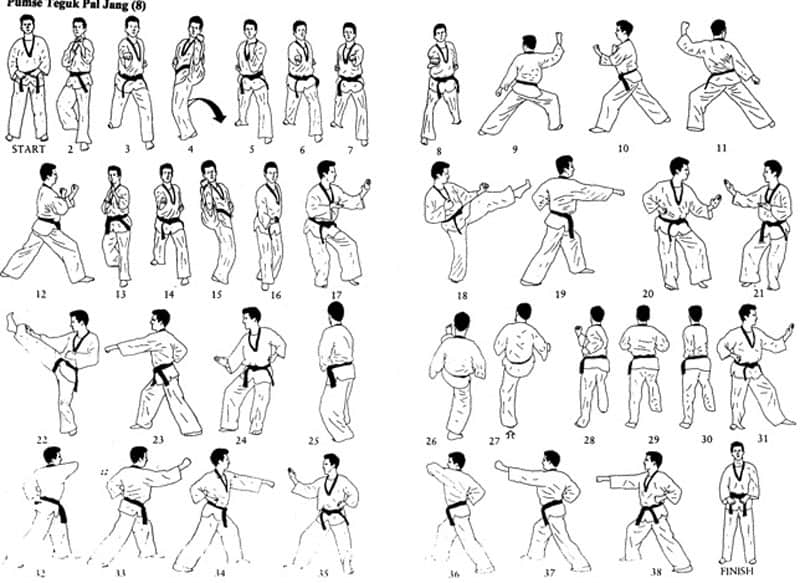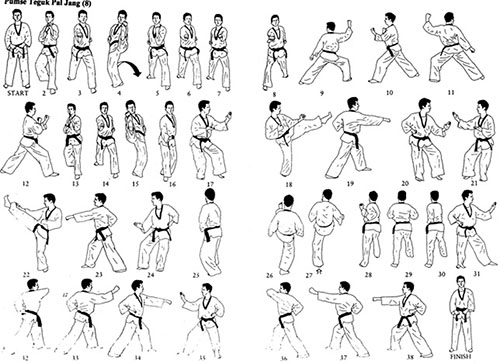
The TaeKwonDo Form 8 or Poomsae Taegeuk Pal Jang applies the Gon principle of Palgwe. Gon symbolizes the earth, the source of life. Keon is the father, Gon is the mother. The earth is where the creative force of heaven is realized. Gon represents the receptivity of the earth.
It is moist and heavy, sinking into the ground. Gon is also gentle and nurturing. Gon signifies the infinite concentration of Um energy. The earth nurtures in silence and in strength. Gon teaches us the importance of the life force within ourselves, and to respect life in all forms.
Representing the mother earth, from which all life comes, Taegeuk Pal Jang contains all the basic elements of TaeKwonDo, serving both as a review of the beginning forms, and as a foundation of the first Black Belt form.
Besides reviewing techniques already introduced, it adds a Outside Middle Block, a simultaneous grab and uppercut, and a Single Mountain Block.
Terms Used With This Form:
- Joon Bi Seogi – Ready Stance (i.e. “at ease”)
- KiHap – Shout
- Poomsae – Form
- Momtong Makki – Middle Block
- Wesanteul makgi – Mountain Block
- Apkubi Seogi– Front Stance
- Beom Seogi – Tiger Stance
- Batangson Makki – Palm Block
- Kawi Makki – Scissor Block
- Chi Jireugi – Upper Cut Punch
Video Of TaeKwonDo High Red Belt Form – Taegeuk Pal Jang
Its easier to learn this Poomsae if you have both a visual and written version.
TaeKwonDo High Red Belt Form – Taegeuk Pal Jang – Step By Step
Step 1:
From your Joon Bi Seogi, step forward once and get into Right Back Stance which is executed by moving one leg forward and bending your back leg 45 degrees while only slightly bending the front leg.
While doing this, execute a Double Middle Block by pulling in your arms and pushing them out, keeping your hands in fists, arms folded 90 degrees, left hand’s knuckles pointing downward as the left arm is under the right, and the right hand’s knuckles are facing the sky and hovering over the left.
Step 2:
Shift into Left Front Stance and deliver a right middle punch.
Step 3:
Deliver a right Dubal Dang Seong Chagi by performing two consecutive front kicks with alternating legs; the first kick is a normal front kick and the second in the air. After this, yell, and consecutively execute a left middle block and two alternate middle punches starting with the right fist.
Step 4:
Step your right foot forward once, get into Right Front Stance, and deliver a right middle punch.
Step 5:
Turn 270 degrees to your left on your right foot, simultaneously turning your body to face 90 degrees to your left but leaving your feet in position and executing a left low block and a right mountain high block; the left low block will be blocking your left leg while the right mountain block will be blocking the right side of your head.
Step 6:
Move into Left Front Stance by turning to your left, grab your opponent’s collar with your left hand and as you pull them to your right shoulder, deliver a slow right Uppercut to their chin. An Uppercut is delivered by pulling in your attacking arm and pushing it out with great force upwards.
Step 7:
Cross your left foot over the right foot and continue to step towards that direction with your right foot while turning your head to face the same direction; in other words, take two steps backward from your previous position and turn your head 180 degrees. Execute a right low block and a left mountain high block just as you did a while ago.
Step 8:
Get into Right Front Stance by stepping your right foot forward, grab your opponent’s collar with your right hand and as you pull them towards your left shoulder, deliver a slow left Uppercut.
Step 9:
Turn 270 degrees to your left on your right foot and execute a left double knife hand block while in your back stance.
Step 10:
Get into Left Front Stance and deliver a right middle punch.
Step 11:
Deliver a Right Front Kick, land your right leg behind the left, step back once with your left foot and get into a Right Tiger Stance as you execute a Batagson Montong Maki.
Step 12:
Turn 90 degrees to your left, get into Left Tiger Stance, and execute a Right Sonnal Montong Maki.
Step 13:
Deliver a left front kick and land it ahead of your right leg to get in your Left Front Stance and deliver a right middle punch.
Step 14:
Slide your left leg backwards and get into Left Tiger Stance then execute a Left Batagson Montong Maki.
Step 15:
Turn 90 degrees to your right on your left foot and execute a Right Sonnal Montong Maki.
Step 16:
Deliver a left Dubal Dang Seong Chagi, yell, and land in a Right Front Stance as you perform a right middle block followed by two consecutive middle punches starting from the left fist.
Step 17:
Turn 270 degrees to your left on your right foot then get into Right Back Stance and execute a left Sonnal Montong Maki.
Step 18:
Shift to Left Front Stance and deliver a right Reverse Elbow Strike followed by a Right Reversed Backfist and a left middle punch.
Step 19:
Turn 180 degrees to your right with your right foot and get into a Left Back Stance and deliver a Sonnal Montong Maki with your left hand.
Step 20:
Get into Right Front Stance, deliver a left Reverse Elbow Strike followed by a Left Reversed Backfist and a right middle punch. After this, turn 90 degrees to your left and get into Joon Bi Seogi.
Remember the following:
- This form as with all forms should begin and end at exactly the same spot. This indicates the quality of the student’s stances and technique.
- Correct posture and body position must be maintained at all times.
- Muscles of the body should be either tensed or relaxed at the proper, critical moments in the form.
- The exercise should be performed in a rhythmic movement with an absence of stiffness.
- Movement should be accelerated or decelerated according to the specifications of that pattern.
- Exhale on exertion of each technique in order to maximize power.
- Each pattern should be perfected before moving to the next.
- Students should know the purpose of each movement.
Tips
In performing this form or poomsae as well as all the others, you should think not of executing techniques in a vacuum, but rather of responding to attacks from a number of opponents surrounding you.
You should always turn your head first, look at your imaginary opponent, then perform the required block or attack.
It’s also worth mentioning to listen to your body and don’t force yourself to learn something you personally aren’t ready for yet; in cases like these, practice slowly until you feel comfortable enough to try again!
Always wait for the “Baro!” or end signal from your master instructor before getting into Joon Bi Seogi after every form; this shows that you are taught to be disciplined during TaeKwonDo training.

